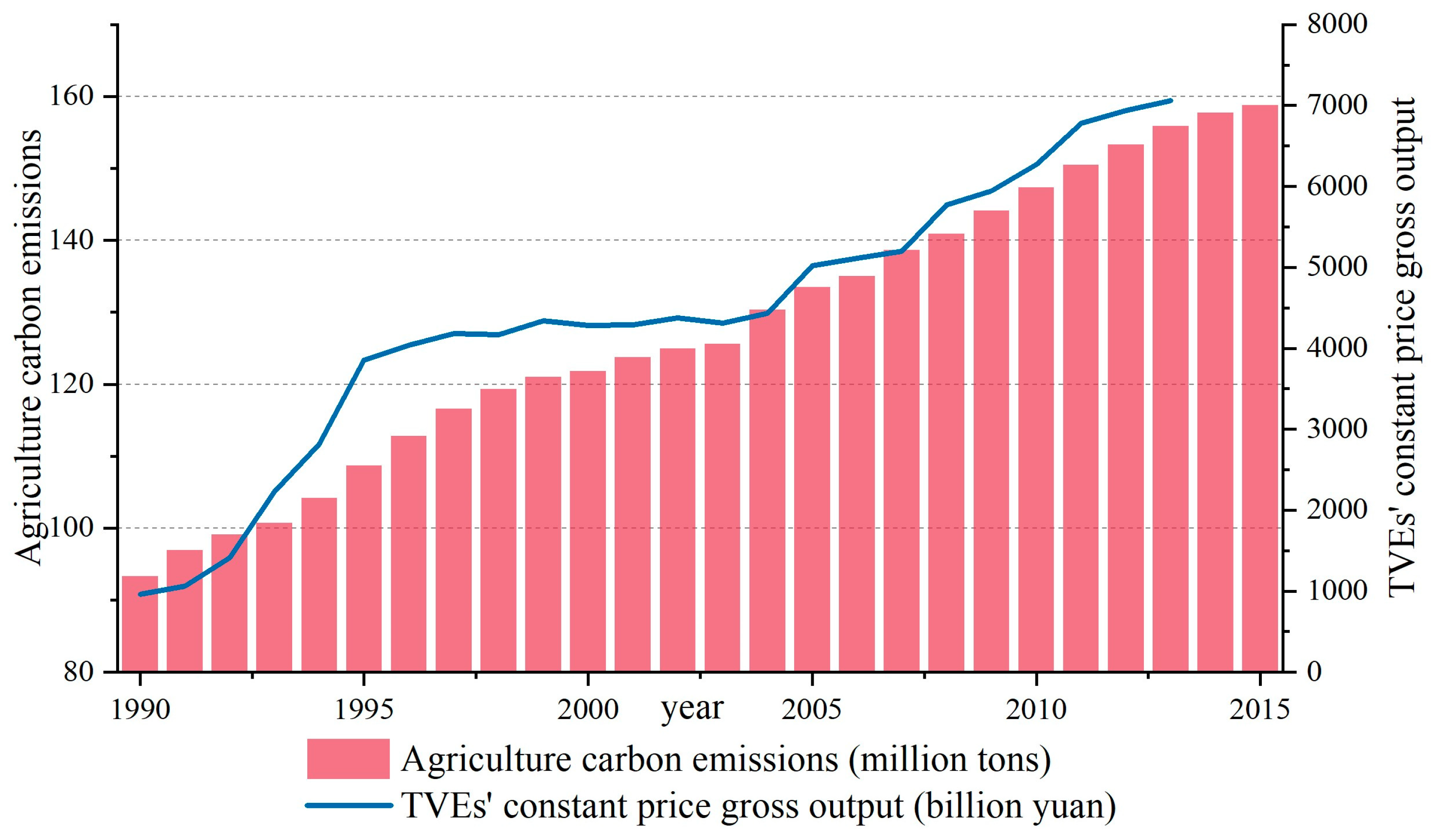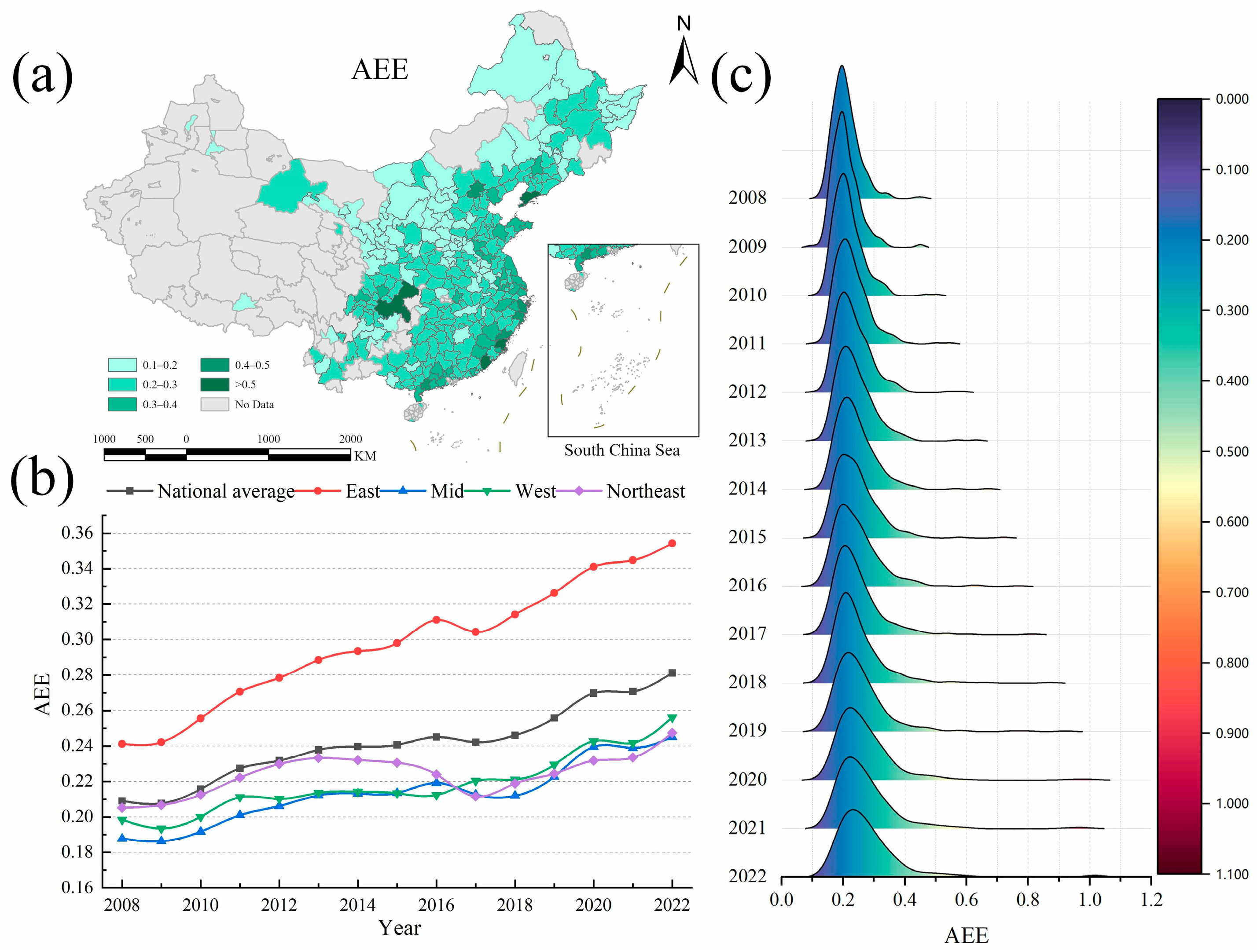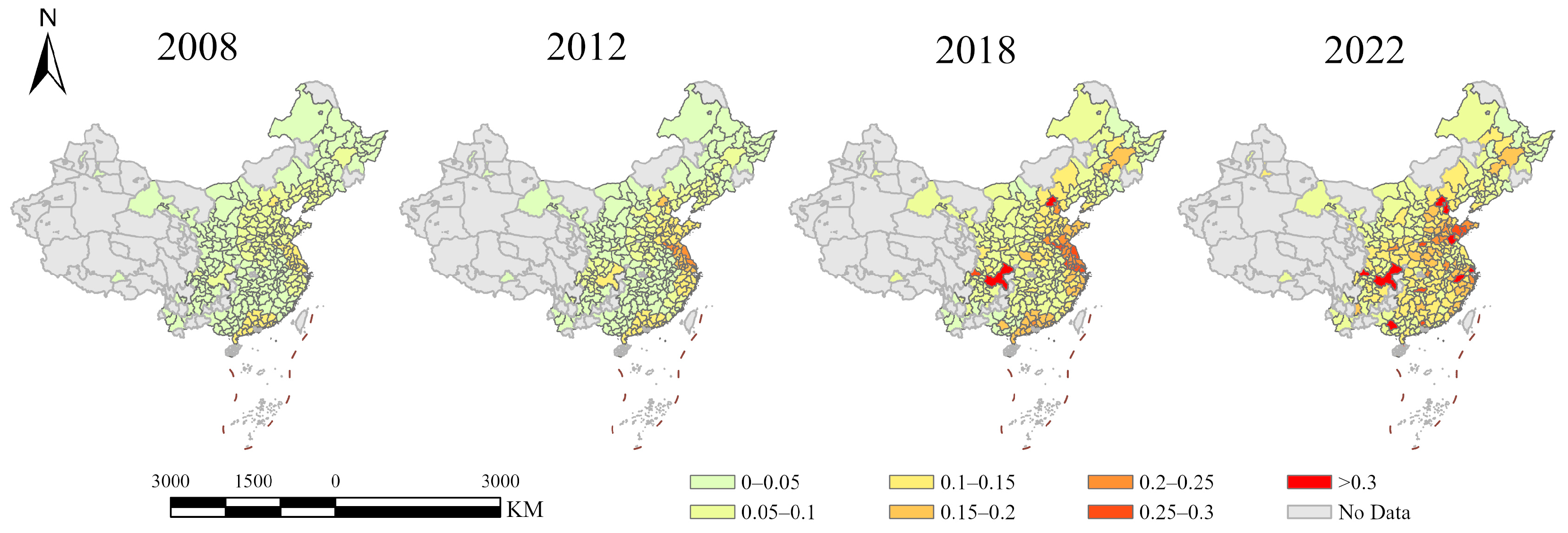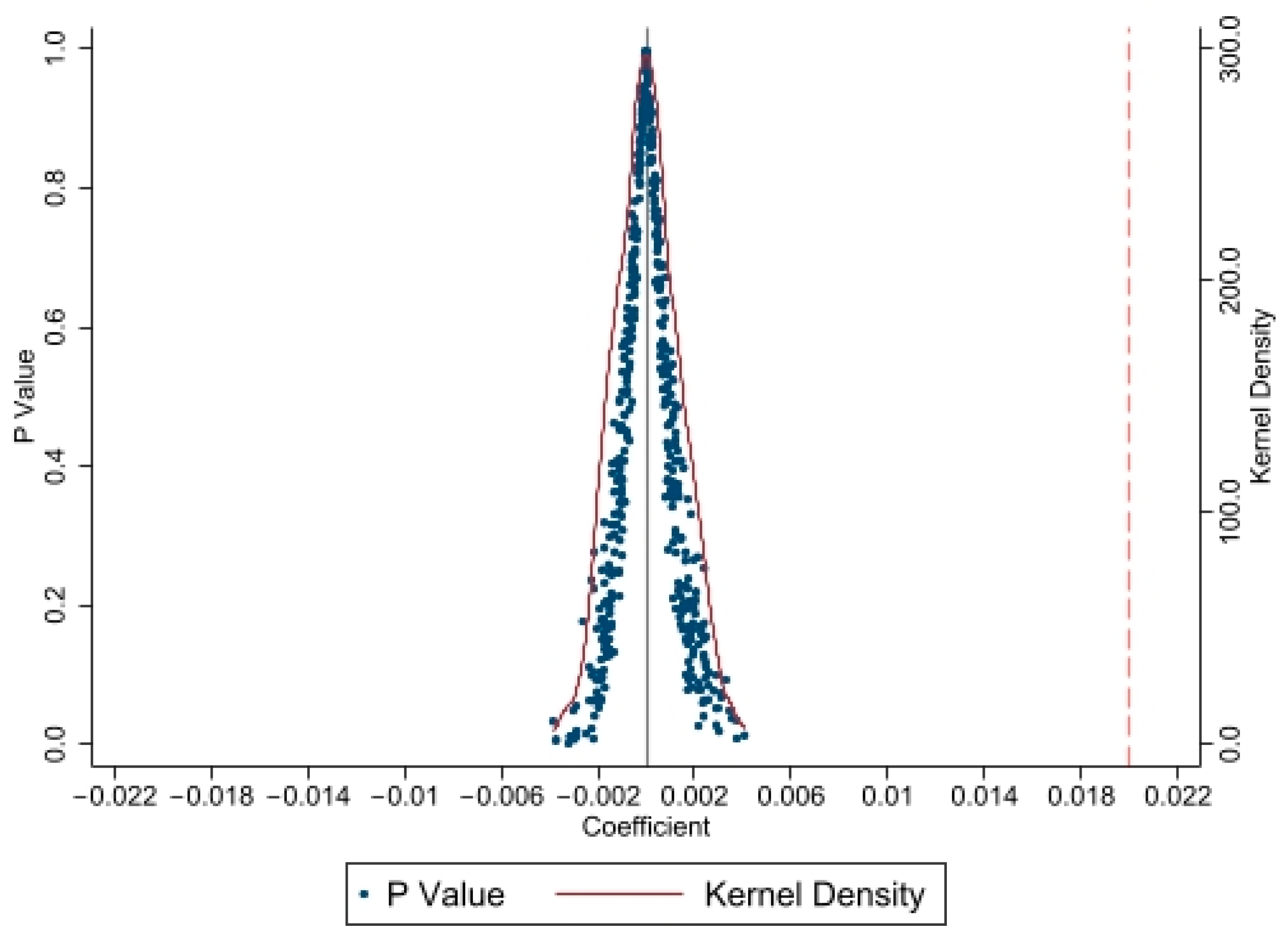1. Introduction
Agriculture serves as a fundamental pillar for human existence and progress by providing food, animal feed, fuel, and a variety of raw materials. With global population growth and evolving dietary patterns, the demand for food and agricultural products is becoming increasingly urgent [
1]. The UN projects that the global population will peak at 10.3 billion by the 2080s, and expanding agricultural production is key to meeting the food needs of a growing population. This can be achieved either through intensification—such as increased use of fertilizers, pesticides, water, or improved management practices—or by expanding arable land [
2]. However, both approaches consume substantial resources and may lead to environmental degradation, exhibiting characteristics of regional relevance, spatial spillover, and negative externalities [
3]. Given the strong interdependence between agriculture and the environment [
4], under the conflict between limited resource constraints and increasing food demand, spending fewer resources and achieving cleaner outputs through improving agricultural ecological efficiency (AEE) helps achieve sustainable development goals (SDG) [
5]. Sustainable agriculture requires that farmers continue producing crops and livestock without degrading environmental or resource bases, while maintaining economic viability and social stability [
6]. Therefore, improving both economic and ecological efficiency in agricultural production lies at the core of sustainable agricultural development.
Although rural regions are essential for sustaining agricultural production, many in developing countries continue to suffer from persistent economic underdevelopment and inadequate living standards. In some cases, rural industrialization has driven rapid economic growth and increased household incomes, but the accompanying environmental consequences are mixed and often concerning [
7]. Environmental issues such as carbon emissions are closely linked to rural human development [
8], highlighting the inherent tension between agricultural sustainability and rural development. Since reform and the opening-up policy, township and village enterprises (TVEs) in China have undergone remarkable growth and contributed significantly to rural industrial development. However, this industrialization has not led to corresponding improvements in agricultural production conditions. Instead, agricultural expansion has been accompanied by environmental degradation, without notable gains in agricultural eco-efficiency.
Figure 1 shows the changes in agricultural carbon emissions during the development process of TVEs, indicating a high correlation between the two.
As the world’s largest developing nation, China confronts challenges related to uneven development between its urban and rural regions, as well as disparities between the industrial and agricultural sectors. In response, China has implemented the Rural Revitalization Strategy, emphasizing industrial revitalization as the cornerstone and essential element for overall rural revitalization. Within this strategy, thriving rural industries are identified as the primary goal, and Rural Industrial Integration (RII) serves as a vital means to achieve rural industrial prosperity [
9]. In 2015, the Chinese government first advocated for the integration of the three rural industries, with the goal of improving factor allocation between industry and agriculture and across urban and rural areas, ultimately enhancing rural incomes and addressing urban-rural development imbalances [
10]. Since then, the Chinese government has frequently underscored the importance of RII in official documents, supported its development through policy incentives, and identified a number of pilot demonstration counties for rural industrial integration development in 2016. RII has promoted diverse innovative agricultural forms, including internet plus agriculture and multifunctional agricultural practices [
11], helping to address challenges such as resource scarcity and technological backwardness in traditional agriculture. Unlike conventional rural industrialization, RII focuses on blending agriculture with other industries, encouraging the growth of secondary and tertiary sectors while achieving optimal allocation of resources and factors across different sectors [
12]. Therefore, under the dual objectives of improving rural livelihoods and achieving agricultural sustainability, studying the rural transformation process of China and analyzing the impact of RII on AEE holds significant practical value and offers valuable insights for developing countries seeking to balance environmental protection with economic growth.
This study focuses on the following key questions: (1) Can China’s RII practices achieve coordinated development between rural industrialization and sustainable agriculture? That is, while achieving rural industrialization, can RII improve AEE and thus promote sustainable agricultural development? (2) Can the impact of RII on AEE be empirically verified? Are there spatial spillover effects associated with RII’s influence on AEE? (3) What is the specific mechanism by which RII affects AEE, and what are the underlying pathways? (4) Does the impact of RII on AEE exhibit heterogeneity? The findings of this study aim to address these questions and reveal the underlying mechanisms, thereby providing scientific evidence to inform policy decisions that support both sustainable agricultural development and rural industrial progress. The structure of the remaining part of the article is as follows:
Section 2 reviews the relevant research literature;
Section 3 conducts theoretical analysis and proposes hypotheses;
Section 4 introduces the model methods and variable selection;
Section 5 analyzes and discusses the results; and
Section 6 presents conclusions and implications.
2. Literature Review
Ecological efficiency has become a valuable tool for assessing sustainability, as it directly links environmental impacts with economic performance and has been extensively utilized in agriculture [
13,
14]. AEE denotes the capability of agricultural production to deliver high-quality outputs and services within the limits of the agroecosystem’s carrying capacity, while minimizing resource depletion and environmental harm [
15]. Improving AEE is essential for achieving the sustainable development goals (SDGs) and maintaining food security. Various methods exist to measure AEE, with stochastic frontier analysis (SFA) and data envelopment analysis (DEA) being the most commonly employed due to their ability to produce highly correlated results in most cases [
16,
17]. DEA, a non-parametric method, is particularly suitable for evaluating ecological efficiency because it does not require a pre-specified production function and allows for multiple inputs and outputs. For instance, Liu et al. [
18] employed super SBM model to evaluate interprovincial AEE levels across Chinese provinces and examined their spatial characteristics. Yang et al. [
19] argued that incorporating agricultural carbon emissions as undesirable outputs provides a more accurate representation of AEE in China. Studies on AEE have been conducted at the micro level focusing on farms [
20], the regional or meso level [
21], and the national or macro level [
22].Given that AEE encompasses agricultural production, economic growth, and ecosystem services, many factors have been found to influence it, including urbanization [
18], resource endowments [
23], agri-environmental schemes [
24], and so on.
Previous studies have mainly explored the factors influencing AEE from the angles of socioeconomic development and policy measures. Despite growing interest in rural development, the specific contribution of rural industrialization has received limited scholarly attention. Studies investigating the effects of macro-level industrial development on ecological efficiency have predominantly centered on industrial agglomeration [
25], industrial structure and upgrading [
26], and industry integration [
27]. and the impact on ecological efficiency often exhibits significant spatial correlations [
28,
29]. Despite this, the link between rural industrial development and AEE remains underexplored, with limited empirical evidence available, and this research aims to bridge that theoretical and empirical void.
Rural industrialization is intended to stimulate economic growth and enhance farmers’ incomes. Long et al. [
30] indicate that rural regions in eastern coastal China have leveraged their locational advantages to develop processing industries, trade, and tourism, thereby achieving rural industrialization and prosperity. However, such regions are often deeply integrated into the urbanization process and are more likely to benefit from development opportunities [
31]. This model of rural industrial development, which is not directly connected to agriculture, is difficult to replicate in less advantaged areas. For decades, China’s urban-biased development policies have concentrated resources in urban areas, contributing to gradual decline of rural regions [
32]. To reverse this trend, the Chinese government introduced the Rural Revitalization Strategy, placing strong emphasis on rural industrial development and the advancement of RII as essential means to improve farmers’ livelihoods and reduce the urban–rural divide [
33]. Unlike the traditional approach of establishing urban-type industries in rural areas, RII focuses on rural contexts and is closely linked to agriculture and farmers [
34]. The concept of industrial integration remains loosely defined in academic discourse. Most scholars suggest that integration blurs, narrows, or even dissolves industrial boundaries, thereby enhancing industrial performance through collaboration and innovation [
35]. It also strengthens the linkages between products and services [
36] and fosters the development of more advanced industrial structures [
37]. RII also refers to the cross-sectoral and intensive allocation of capital, technology, and resources, facilitating the integration of agriculture, industry, and services, with the ultimate goal of extending agricultural value chains and increasing farmers’ incomes [
12]. Currently, there is no standardized method for measuring RII. Existing studies employ various approaches such as Herfindahl Index [
38] and composite index methods [
39]. Promoting RII has accelerated the development of non-agricultural industries in rural areas; however, research on rural industrial integration and its impact on AEE remains limited. The underlying mechanisms linking rural development and agricultural sustainability have yet to be systematically explored or empirically tested. To fill existing research gaps, this study develops a theoretical model to explain the RII and AEE relationship and conducts empirical analysis to assess the alignment between rural industrialization and sustainable agriculture.
This study utilizes econometric modeling to investigate the effects of RII on AEE in China, thereby revealing the connection between rural industrialization and sustainable agriculture. Building upon the existing literature, this research makes several innovative contributions. First, it constructs a novel theoretical framework grounded in industrial structural transformation and producer behavior, interpreting the mechanisms through which RII influences AEE from the perspectives of factor mobility, technological integration, and environmental externalities. Second, to strengthen the reliability of the empirical analysis, an extensive panel dataset encompassing 285 prefecture-level Chinese cities over 15-year period is utilized in this study. Third, based on insights from previous studies, this research develops a new composite index to measure RII at the prefecture level, aiming to capture the multidimensional nature of RII more accurately. Fourth, by introducing spatial econometric model, verify spatial spillover effects of RII on AEE.
3. Theoretical Mechanisms and Hypotheses
RII is based on agriculture and intensively allocates various capitals, technologies, and resources across borders to integrate agricultural production, agro-processing and marketing, cultural tourism, and services to foster close linkages and coordinated development among rural industries in primary, secondary, and tertiary [
34]. Although primary objective of RII is to promote rural economic growth, its close linkage with agriculture facilitates the flow and spread of production factors and technological knowledge between agriculture and other industries, ultimately influencing agricultural production processes. The specific mechanisms are illustrated in
Figure 2. Optimization of factor allocation and reduction of negative externalities helps promote the enhancement of AEE, and this impact may also cross geographical boundaries to generate spatial spillover effects. For this reason, we propose Hypothesis 1:
Hypothesis 1. Promoting the development of RII can enhance AEE.
First, RII will enable the flow of labor, capital (machinery, fertilizer, agriculture, etc.) and land factors between agriculture and other industries, thereby improving resource allocation efficiency. On one hand, RII promotes industrial development, which increases employment opportunities and raises farmers’ incomes [
38]. This elevates labor opportunity costs for agricultural producers, resulting in a decreased agricultural labor supply. Consequently, producers are more likely to substitute labor with other inputs, demonstrating a substitution effect. For semi-operating farmers who earn non-agricultural income, enhanced capital endowment encourages additional capital investment, thus generating an income effect [
40,
41]. These shifts result in increasing output elasticity of capital inputs (machinery, fertilizers and pesticides), and the output elasticity of labor decreases [
42]. Increased use of agricultural machinery can improve green efficiency [
43], but the application of fertilizers and pesticides directly increases pollution and carbon emissions, and excessive use also reduces AEE. On the other hand, RII drives non-agricultural land use in rural areas, leading to a reduction in cultivable land and a greater dependence on substituting inputs. Nonetheless, RII-induced non-farm employment may promote farmland transfer [
44], leading to land consolidation and scale-oriented agricultural operations [
45], which can in turn enhance AEE. Among these factor flows, RII directly promotes labor transfer, provides non-agricultural employment opportunities in rural areas, and thus increases farmers’ incomes. Increased farmers’ incomes lead to increased inputs of mechanized fertilizers and pesticides in agricultural production, while non-agricultural employment facilitates land transfer. These lead to the flow of various factors between the agricultural and non-agricultural sectors. Therefore, we propose Hypothesis 2:
Hypothesis 2. RII can promote rural labor transfer, thereby affecting the improvement of AEE.
Second, RII promotes technological integration among primary, secondary, and tertiary industries, allowing agricultural production to benefit from the positive externalities associated with such integration, thereby facilitating technological progress. The increased demand for transportation and logistics induced by RII stimulates the supply of public infrastructure. In regions with more advanced industrial development, local governments are more likely to enhance public service provision. Supported by favorable policies and fiscal transfers, these regions often experience improvements in transportation infrastructure [
46]. Improvements in infrastructure have facilitated the flow of various factors and the spread of knowledge, effectively promoting technological advancement, thus directly enhancing AEE [
19]. RII also promotes cross-industry dissemination of knowledge and technology, further fostering innovation. For example, the application of digital technologies [
47] is becoming increasingly prevalent in agricultural product marketing and rural tourism promotion. Through RII, these technologies are more likely to spill over into agricultural activities, enabling the adoption of new technologies and innovations in farming practices. The technological advancement driven by knowledge diffusion enhances agricultural productivity and contributes to improvements in AEE [
48]. We propose Hypothesis 3:
Hypothesis 3. RII can improve AEE by promoting agricultural technology innovation.
Third, RII helps internalize environmental externalities and achieves the joint maximization of economic and environmental utility, thereby reducing pollution and carbon emissions. Through industrial integration, the primary, secondary, and tertiary sectors become interlinked and jointly profitable. As a result, rural regions prioritize maximizing total returns rather than maximizing profits from individual sectors. First, RII extends the agricultural value chain, expands market access, and promotes brand development, which boosts the value of agricultural outputs and contributes to sales stability, and this process can benefit agriculture by reducing transaction costs [
34]. These changes raise quality standards for agricultural raw materials. High-value green and organic agricultural products often require strict control of pollution and fertilizer use during production. Such organic farming practices can reduce agricultural carbon emissions and enhance AEE [
49]. Moreover, RII diversifies agricultural functions by fostering agriculture-based rural tourism. The development of tourism creates demand for high environmental quality, which in turn imposes constraints on agricultural pollution and carbon emissions. This environmental constraint positively contributes to improvements in AEE [
50]. We propose Hypothesis 4:
Hypothesis 4. RII can reduce agricultural carbon emissions, thereby improving AEE.
RII may not only directly influence local AEE but also exhibit spatial correlation, potentially generating spillover effects on AEE in neighboring regions. Industrial integration improves the efficiency of regional resource allocation and advances the comprehensive integration of organizations, markets, and technologies. Importantly, such integration is not confined to a single locality. For instance, market expansion resulting from RII can attract factor inflows from nearby areas and provide more products, thereby reducing transaction costs and generating positive externalities across regions, this constitutes the spatial spillover effect of RII [
51]. However, RII can also have a negative spatial impact on the AEE of other regions, exhibiting a “siphon effect.” Regions with high AEE levels can generate greater returns, which attracts various resource factors from neighboring regions, negatively impacting the AEE of other regions [
52]. These influences are all possible and they may affect the surrounding areas in different ways, so we propose Hypothesis 5:
Hypothesis 5. RII affects AEE in neighboring regions through spatial spillover effects.
6. Conclusions and Implications
6.1. Conclusions
The pursuit of rural industrialization and sustainable agricultural development lies in achieving both farmers’ prosperity and meeting broader societal needs, while China’s RII practice has promoted the coordinated advancement of these two goals. RII has already achieved great results in promoting rural industrial development in the rural revitalization program, and our research focuses on the potential impact of RII on agricultural sustainability. By verifying the promoting effect of RII on AEE, we demonstrate that advancing RII can simultaneously achieve rural industrialization and agricultural sustainable development. This study uses a 2008–2022 panel of 285 prefecture-level cities in China to measure AEE with a super-efficiency SBM model, constructs a comprehensive index system for RII, empirically test the impact and spillover effects of RII on AEE using panel fixed effect models and spatial econometric models, and adopts the mediation effect model to analyze the specific mechanism. Results indicate RII significantly enhances AEE, and the findings still hold under various robustness tests and instrumental variable regressions. By analyzing the impact of policy shocks, we find that after the Chinese government implemented RII support policies, AEE increased significantly. In addition, the impact of RII on AEE also has a spatial spillover effect, and presents the characteristics of the “siphon effect”. The results of regional heterogeneity show that the spillover effect in the eastern region is negative, the central and western regions have positive spillover effects, and the spillover effect in the northeastern region is not significant. Considering the heterogeneity of the industrial integration model, RII has a stronger promotion effect on AEE under the development model dominated by the integration of primary and tertiary industries.
6.2. Implications
Promoting RII development can effectively enhance AEE, which is of significant importance to advancing rural industrialization and sustainable agricultural development. RII not only directly promotes the development of non-agricultural industries in rural areas, but also enhances AEE, thereby synergizing agricultural sustainability with rural industrialization and achieving their common development. These findings offer valuable insights for regions facing underdeveloped rural, low agricultural productivity, and severe environmental pollution. From the RII practice in China, this study puts forward the following policy implications for rural industrialization and agricultural sustainable development.
First, since RII can significantly promote the improvement of AEE, some regions can leverage the comparative advantages of agriculture and rural resources during the industrialization of rural areas, promote the flow of production factors between the primary, secondary, and tertiary industries, and enable integrated development among these industries to maximize overall economic benefits. Policymakers can implement pilot policies in selected regions, leveraging the demonstration effect of regions with RII potential to promote overall RII development.
Second, since RII has a mediating effect on AEE, in the process of advancing RII development it is necessary to maintain market stability and promote the normal flow of factors, encourage technological innovation and promote technological exchange to improve technological levels, aim at maximizing common interests, and encourage the adoption of green agricultural technologies to reduce the impact of environmental externalities.
Third, because RII’s impact on AEE has spillover effects, exhibiting a “siphon effect,” it is necessary to avoid negative spatial externalities between regions. Different regions should reduce unnecessary competition for resource factors, develop complementary industries, and enhance technological innovation to boost AEE.
Fourth, considering the heterogeneity of regions, differentiated policies should be implemented based on the relative advantages of regional resources and resource distribution. For the eastern regions, it is necessary to avoid adverse spatial externalities generated during the development of RII, focus on technological innovation, reduce reliance on resources, and thereby avoid unnecessary competition. The development gaps between central and western regions are significant, and resource factors in different regions can complement each other to some extent, so regional exchanges and mutual connectivity should be encouraged. In the northeastern region, the promoting effect of RII on AEE is relatively weak, and the spillover effect is also not strong, so during the development process, it is necessary to identify the relative advantages of its own industries and steadily promote AEE growth.
Fifth, different RII development models have varying effects on AEE. The integration of primary and tertiary industries is more effective in promoting AEE. Therefore, for regions with a certain level of RII development, a transition to a more advanced development model is an appropriate option. However, regions undergoing this transition should also consider their own resource constraints; blindly pursuing advanced industries is unsustainable.
This study obtained some valuable new findings on the impact of RII on AEE, but it also has certain limitations. Due to data availability, some prefecture-level cities in the western region were not within the sample. Future research will utilize larger sample sizes to generate more realistic results.











